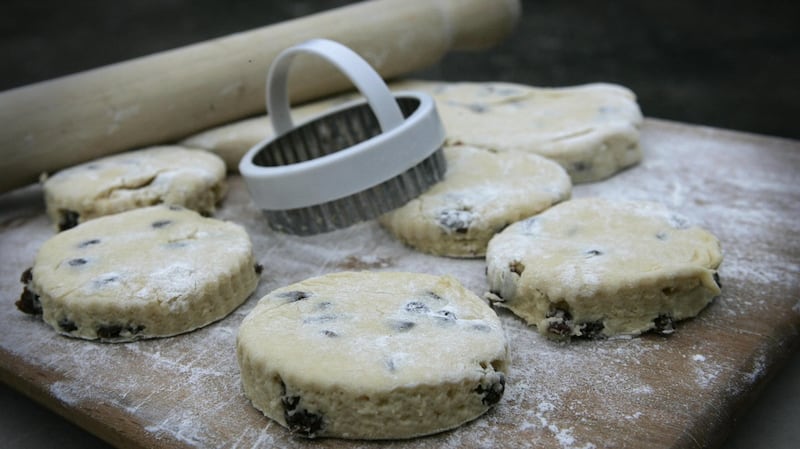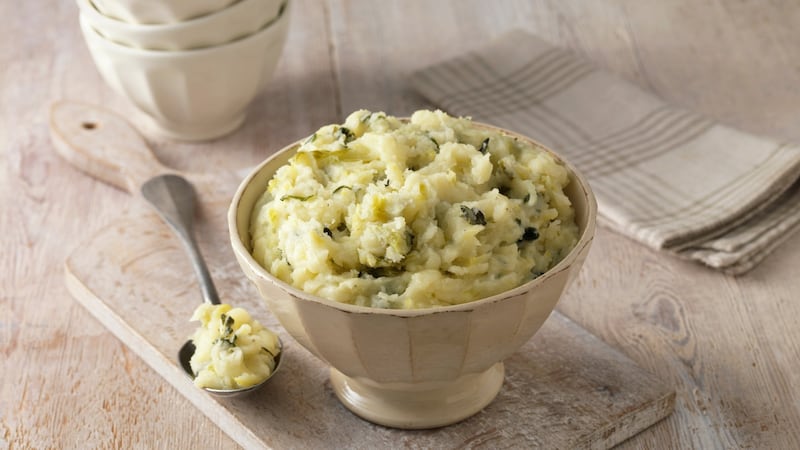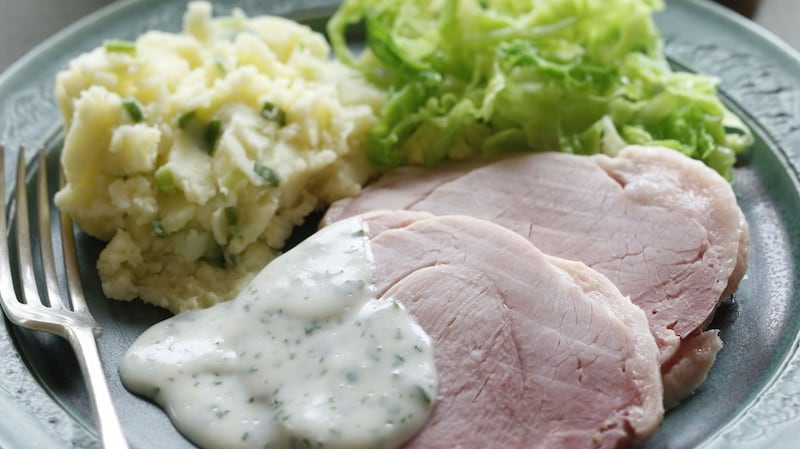Ireland may not be as world renowned for its cuisine as the likes of France, Thailand, or Japan, but it does have a distinct advantage: simple recipes that can be rather easily adapted for use with local ingredients wherever in the world you live.
As St Patrick's Day approaches, we decided to rifle through the archives of The Irish Times to see if we could find some old recipe favourites for our readers overseas to recreate a taste of home this week. We were thinking of colcannon, coddle and apple pie perhaps – something you could make yourself wherever in the world you may be.
Not everything was suitable for modern sensibilities or schedules, however. The Irish Times has been featuring recipes on its pages for more than 120 years, with some more appealing than others. Take Brawn, as listed in the Women's Work and Household Hints column on Saturday, April 26th 1902. It features a recipe that begins thus: "To make this you require a pig's head, two sheep's tongues, teaspoonful of chopped sage and parsley, pepper and salt."
Aside from sounding very unappealing, it is a world away from fast food. “Wash the head in salt and water to remove all the blood, rub the head with salt and leave for three days . . . ”
There’s little point in republishing that one, but we did find other more simple and appetising recipes which you might like to try.

Fruity sweet scones
The inspiration is a recipe by Ann Hannon published under the heading "If the Milk Goes Sour" in July 1949. Hannon had some good advice for readers on how to prevent milk from going off, such as standing the jug in deep basins of cold water. In warm weather, she advised boiling the milk with borax or using it to make sweet scones. Here we have a more modern version of that recipe, which uses fresh milk.
Ingredients
900g (2lb) plain white flour
Pinch of salt
3 tsp baking powder
50g (2oz) golden caster sugar
175g (6oz) butter, cut in cubes
3 eggs
425 ml (¾ pint) milk
100g (4oz) dried raisins, cranberries, cherries or blueberries
Method
Preheat the oven to 220°C / fan oven 200°C /Gas Mark 7.
Put some flour on a board or a work surface for later.
Wash the fruit and soak it in tea or warm water for a few hours if possible. Sieve the flour, salt and baking powder into a big mixing bowl. Give it a good stir to make sure the baking powder is well dispersed. Drain the fruit and dry with a paper towel. Add the caster sugar and the fruit, and then mix it up. Add the butter and rub it in with your fingers until the mixture looks like breadcrumbs.
Whisk together the eggs and milk in another bowl. Make a well in the centre of the other mixture, then pour in the eggy mix to make a soft dough, using your hands to mix it up. (Keep aside about one tablespoon for later.) It should be pliable but not sticky.
Turn the mixture onto the floured board and knead it gently. (Not for too long. It’s not bread.) Then roll it out with a floured pin until it is about 3cm (1in) thick. Use a round 5cm (2in) cookie cutter to make shapes or cut it up with a knife.
Place on to greased baking sheets. Knead the rest of the dough and then cut again.
Brush each scone with a little of the eggy mixture, then sprinkle with caster sugar. Bake in the oven for 10-15 minutes.
Once they have risen and look golden, remove from the oven and cool on a wire rack. Then cut in half, slather over some more butter or cream and serve with strawberry jam.
Baked salmon with tarragon
Salmon has been a favourite in Ireland since the time Finn MacCumhaill burnt his thumb while cooking the salmon of knowledge and thereby gained the wisdom to become a leader.
In a Women First column on the "Secrets of Salmon" on July 10th 1970, Theodora Fitzgibbon gave instructions on how to bake or to poach a whole salmon. Then she suggested turning the leftovers into kedgeree or salmon fritters. She bemoaned the fact that so many households no longer had a fish kettle, a long low fish-shaped saucepan. Such kettles are still scarce, but salmon is still popular in Ireland whether it's smoked, panfried or baked.
Ingredients
400g salmon fillets or steaks (one piece per person)
1 lemon
1 bunch of fresh tarragon or dried tarragon or parsley
Butter or olive oil
Sea salt
Method
Preheat the oven to 190 degrees/170 fan oven/ gas mark 5
Oil the base of a casserole dish or baking tray. Place the salmon skin side up in the dish with a little water so it does not dry out. Squeeze the lemon juice on top. Add a dash of olive oil or a few knobs of butter if you like a richer taste. Sprinkle with sea salt. Then cover. If you don’t have a lid, you can use a tinfoil tent. Or you can leave it open, but expect the fresh tarragon to get crispy. Bake for 15 to 20 minutes. Serve with a green salad and rice or roast potatoes.

Colcannon
On days when traditional recipes were required for the newspaper, Theodora Fitzgibbon often plumped for Colcannon, which is essentially mashed potato with shredded cabbage. Her slightly more sophisticated recipe, as printed in the newspaper on October 29th 1983, is still one worth trying out.
Ingredients
450g/1lb each of cabbage or kale
450g/1lb potatoes
2 small leeks or some spring onions
150ml/5fl oz of milk or cream
Pinch of nutmeg or mace
Salt and freshly ground pepper
100g (4oz) melted butter
Method
If using kale, strip the leaves from the tough stalk, or remove stalk from the cabbage. Cook quickly in boiling salted water, but do not overcook. Drain very well and chop finely or put into a food processor. Cook the potatoes and while they are cooking, chop the leek and simmer in the milk until it is just tender, but not mushy. Drain the potatoes, season and mash them well. Then stir in the cooked leek and milk, adding more milk if needed. Beat well. Finally blend a little of the kale or cabbage into this until it is all absorbed and is a greeny fluff. Add nutmeg and taste for seasoning. Heat the entire mixture very gently, then either add melted butter or make a hole in the middle of the colcannon in a warmed dish and pour it in. Serves 6-8.

Bacon and cabbage
You have to wonder what Irish people ate in the early years of inhabiting this island. It seems that many of our favourites are relatively recent arrivals. "Cabbage, so beloved of the Irish, is indigenous to Asia and did not arrive in the British Isles until the 16th century," Theodora Fitzgibbon wrote in her 1983 book Irish Traditional Food. The Egyptians adored cabbage and raised altars to it, Fitzgibbon writes in her column for The Irish Times in 1987.
Over the years, The Irish Times has often written about cabbage and bacon, particularly how much the vegetable or the meat cost, but recipes were not too easy to find in back issues. Perhaps it was just too obvious to explain to readers:
Boil some bacon in a big pot and add then about 5 minutes before it finishes cooking add the cabbage – shredded or not as you wish. Drain and serve with a mountain of floury mashed potatoes. Job done. What could be simpler.
The Irish Times version as updated by Theodora Fitzgibbon for the edition of January 24th 1987 featured sour cream and fried, rather than boiled, bacon. It is definitely worth trying. But first, she explains how to make 10-minute cabbage.
10-minute cabbage
Trim off old and tough outer leaves and also trim the stalk and stump. Cut it in halves or quarters if large, then either with a machine or a sharp knife shred it, but not too finely. It should still be large enough to give fibre and texture.
Heat about two to three tablespoons of oil, according to the amount of cabbage, in a saucepan and when it is hot, toss in the shredded cabbage and at once turn it all over so every part is coated with the oil. Let it cook over a medium heat for about three to five minutes, then add one cup of water or chicken or bacon stock. You shouldn’t need any more unless the cabbage is enormous. Season to taste and if you like add a good pinch of whole cumin or caraway seeds and let it simmer quite rapidly until it is just tender not more than 7-10 minutes. Serve at once and do not drain as the liquid should be almost absorbed.
Dress it afterwards with a good pinch of ground nutmeg or mace, a knob of butter and a very little thick cream.
Non-traditional cabbage and bacon
Ingredients
8 thick back rashers
450g (1lb) cabbage
150ml (¼ pint) sour cream
Salt and pepper
A lemon
Method
First grill or fry the rashers of bacon on a medium heat until crisp. Then drain on paper and crumble up. In the bacon fat, sauté the shredded cabbage for about five minutes until just wilted. Stir in the sour cream, salt and pepper and cook for two minutes.
Add one tablespoon of lemon juice, or to taste, transfer the cabbage to a serving dish and sprinkle the bacon over the top. Serves four.















